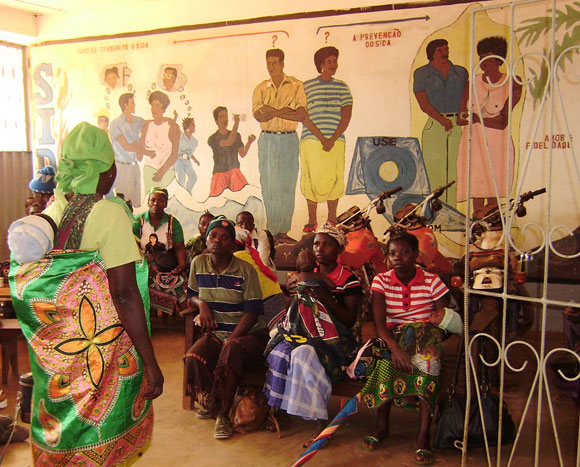
It was fantastic to have the opportunity to visit Manica province recently, and to see the hard work being undertaken by dedicated health workers in a number of different health centres. So, to help celebrate World AIDS 2010 I am posting a picture from this recent trip showing the waiting area in Sussundenga Health Centre, Manica province.
I love the mural in this picture, which decorates the back wall in the waiting area of the health centre. The messages in the image about HIV and AIDS (SIDA is the acronym in Portuguese) are clear. The image on the left of the mural highlights the potential dangers of having multiple partners (multiple, concurrent partnerships are considered to be one of the main driving forces behind the HIV epidemic in Mozambique). The central image promotes the importance of knowing one’s HIV status (the question marks over the man’s and woman’s heads in the centre of the mural identify they do not know their HIV status. There is then a great image of the couple ensheathed by a protective condom.
I have posted other blogs (here and here) on HIV and AIDS in Mozambique. Indeed, I started my blog career in the run up to World AIDS Day 2008. DFID supports the National AIDS Council (CNCS in Portuguese) which is the government body responsible for coordinating the national response. We are also supporting the Rapid Results Fund, which will be providing small grants to community organisations through the Mozambican Network of AIDS Services Organizations (MONASO) .
This year I have chosen to use a few statistics from Manica to highlight some of the on-going challenges of tackling HIV and AIDS.
In Manica province 28 of the 90 plus health posts offer access to anti-retroviral drugs and 4341 new users started treatment in 2009. The number of people registered and attending clinics for HIV decreased from 18,271 in 2008 to 15,093 in 2009, a 17.4% decrease. With 1598 abandoning regular contact with services between 2008 and 2009, some of these having died. The number of recorded deaths in 2008 was 760 compared to 733 in 2009. The good news is that there has been a significant increase in the number of children receiving Anti-retroviral treatment (ARVs), numbers of children on treatment increasing from 1,994 in 2008 to 2,365 in 2009, an 18.6% increase.
It was good to see that condoms were available and being given out in all health facilities, and that posters and signs around the health facilities serve as a constant reminder of the problem. In the coming months, DFID will be exploring ways to strengthen the distribution systems used by the Ministry of Health to ensure that condom, contraceptive and drug distribution is reliable and these commodities do not run. However, there remains a huge amount to do and DFID will continue to work on HIV and AIDS through our support to the health sector in Mozambique. A stronger health system that provides quality care should help reduce abandonment to treatment as seen in Manica province.

1 comment
Comment by Dermot Grenham posted on
Neil
I hope it works but what analysis has been done in this area regarding risk compensation ie the risk that the safety of condoms is oversold and people revert to risky behaviours thinking that they are safe from catching HIV if they use a condom? Also you mention reducing concurrent partners but what about abstinance training and delaying sexual debut? Dermot